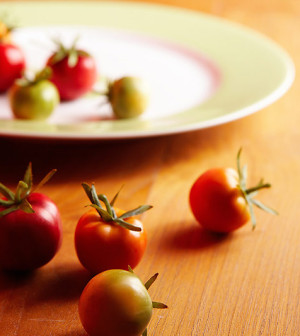- New School Lunch Rules Target Added Sugars, Salt
- Dairy Cows Moved Across State Lines Must Now Be Tested for Bird Flu
- TikTok Riddled With Misleading Info on Health: Study
- Emulsifier Chemicals Are Everywhere in Foods. Could They Raise Diabetes Risk?
- Opioids During Pregnancy May Not Raise Psychiatric Risks for Offspring
- Could Heartburn Meds Raise Your Migraine Risk?
- Drug, Alcohol Abuse Goes Untreated in Many Ex-Prisoners
- Watchdog Group Says U.S. Food Recalls Rose Again Last Year
- Genes Could Mix With Pesticide Exposure to Raise Parkinson’s Risk
- Breast Cancer Survivors Face Higher Odds for Second Cancer
Switching to Healthier Eating May Cost You More


Does it really cost more to stick to a healthy diet? The answer is yes, but not as much as many people think, according to a new study.
The research review combined the results of 27 studies from 10 different countries that compared the cost of healthy and unhealthy diets.
The verdict? A diet rich in fruits, vegetables, nuts and fish costs about a person about $1.50 more per day — or $550 per year — compared to a diet high in processed grains and meats, fat, sugar and convenience foods.
By and large, protein drove the price increases. Researchers found that healthy proteins — think a portion of boneless skinless chicken breast — were 29 cents more expensive per serving compared to less healthy sources, like a fried chicken nugget.
The study was published online Dec. 5 in the journal BMJ Open.
“For many low-income families, this could be a genuine barrier to healthy eating,” said study author Mayuree Rao. She is a junior research fellow in the department of epidemiology at the Harvard School of Public Health, in Boston.
For example, a family of four that is following the USDA’s thrifty eating plan has a weekly food budget of about $128. An extra $1.50 per for each person in the family a day adds up to $42 for the week, or about 30 percent of that family’s total food tab.
Rao says it’s wouldn’t be such a big difference for many middle-class families, though.
She said that “$1.50 is about the price of a cup of coffee and really just a drop in the bucket when you consider the billions of dollars spent every year on diet-related chronic diseases.”
Researchers who weren’t involved in the review had plenty to say about its findings.
“I am thinking that a mean difference in cost of $1.50 per person per day is very substantial,” said Adam Drewnowski, director of the nutritional sciences program at the University of Washington, in Seattle. He has compared the cost of healthy versus unhealthy diets.
Drewnowski said that at an extra $550 per year for 200 million people would outstrip the entire annual budget for food assistance in the United States.
Dr. Hilary Seligman, an assistant professor of medicine at the University of California, San Francisco, said healthy food can be expensive for families in ways that go beyond its cost at the checkout. For that reason, she said, the strict cost comparison in this review probably underestimates the true burden to a person’s budget.
For example, she pointed out that people in poor neighborhoods that lack big grocery stores may not be able to afford the gas to drive to buy fresh fruits and vegetables. They may work several jobs and not have time to prep foods from scratch.
“To eat a healthy diet on a very low income requires an extraordinary amount of time. It’s doable, but it’s really, really hard work. These studies just don’t take things like that into account,” Seligman said.
Still, Melissa Joy Dobbins, a registered dietitian and a spokesperson for the Academy of Nutrition and Dietetics, said the study should reassure many consumers that “eating healthy doesn’t have to cost more.”
She said the academy recommends the following nutrient-rich, budget-friendly foods:
- Beans. They provide fiber, protein, iron and zinc. Dry beans are cheaper but need to be soaked. Canned beans are more convenient but should be rinsed to reduce the salt content. Canned beans are about 13 cents per quarter-cup serving. Dried beans cost about 9 cents per ounce.
- Bananas. They provide vitamin B6, fiber, potassium and vitamin C. They make an easy grab-and-go snack or quick topping for yogurt and cereal. Once they are the ripeness you prefer, place them in the fridge. The peels will turn black, but the banana itself will keep. Or, peel and freeze for using in smoothies. Cost is about 36 cents each — much cheaper than a candy bar.
- Peanut Butter. One tablespoon of crunchy or smooth peanut butter has around 95 calories, 4 grams of protein and 8 grams of heart-healthy unsaturated fat. Choose natural peanut butter, if possible. It does not have added sugars or fats. Cost for 2 tablespoons is about 27 cents.
- Yogurt. Plain or nonfat yogurt is an excellent source of calcium and protein. It can make a good substitute for sour cream or mayonnaise when you want to cut fat in recipes. To save money, buy yogurt in large tubs instead of single-serve containers. Buy plain yogurt and add your own flavorings such as hot chocolate powder mix or granola/cereal or canned fruit in its own juice. Cost for 6 ounces is about 60 cents.
- Whole-Grain Pasta. It provides more fiber, protein and vitamins than regular pasta. Plan ahead as it takes longer to cook. One ounce of dry whole-grain pasta is about 14 cents.
- Frozen Peas. Frozen vegetables are an excellent alternative to fresh. They are frozen at the peak of freshness and pack important nutrients, and they won’t rot in the crisper drawer. Frozen peas are full of protein, fiber and vitamin A. They’re easy to toss into soups, salads, rice, pasta dishes and stews. They cost about 23 cents per half-cup.
- Almonds. They’re packed with heart-healthy unsaturated fat and antioxidant vitamin E. Save money by buying unsalted raw or blanched almonds in bulk. Cost for an ounce of almonds is about 55 cents.
- Eggs. Protein is one of the most expensive components to people’s diets. Eggs are cost effective at about 11 cents per egg and provide a source of high-quality protein. They’re also very versatile. Have a bowl of hard-cooked eggs in your fridge at all times for a quick breakfast or grab-and-go snack, or to add some protein to a lunch or dinner salad.
- Canned Tuna. It’s packed with protein, heart-healthy omega-3 fats, selenium and B vitamins. Choose packed in water instead of oil. Chunk light tuna has less mercury than albacore. Have it on hand for quick meals like tuna salad sandwiches or tuna on green salads. Tuna cost about 27 cents per ounce. NOTE: The U.S. Food and Drug Administration recommends that pregnant women, women of childbearing age and children limit their consumption of canned tuna. The FDA advises these groups to eat no more than 6 ounces of white, or albacore tuna, and no more than 12 ounces of chunk light tuna, each week.
More information
To find out more about how to eat healthy on a budget, visit the U.S. Department of Agriculture.
More information
To find out more about how to eat healthy on a budget, visit the U.S. Department of Agriculture.
Source: HealthDay
Copyright © 2024 HealthDay. All rights reserved.










